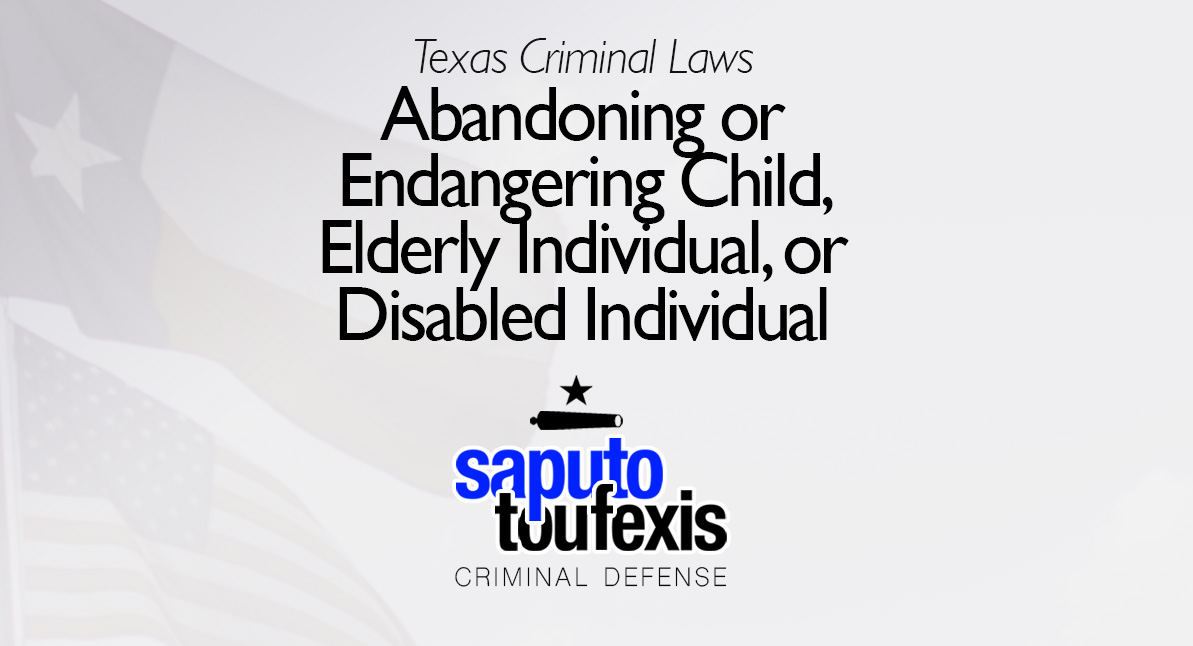The Texas Abandoning or Endangering Child, Elderly Individual, or Disabled Individual law was called simply called Abandoning or Endangering Child until the legislature amended the law in 2023.
FAQs about the
Endangering a Child law in Texas
- What is the current Texas law about Abandoning or Endangering Child, Elderly Individual, or Disabled Individual?
- What is the difference between abandoning and endangering in Texas law?
- Can I get in trouble for leaving my child at home alone?
- Will CPS (Child Protective Services) get involved if I am charged with Abandoning or Endangering a Child?
- Are there any defenses to this law?
- What is the statute of limitation for Endangering a Child in Texas?
- What is the penalty for a Texas Endangering a Child offense?
- Can you get probation for Endangering a Child in Texas?
- What level of crime is Endangering a Child in Texas?
This offense always covered both Abandoning a Child and Endangering a Child, but the law was updated in 2023 to expand the law’s applicability to also covering elderly and disabled people, effective September 1, 2023. Now, the crime includes both abandoning a child, disabled person or elderly person and exposing a child, disabled person or elderly person to imminent danger. The Texas legislature codified this criminal offense in Texas Penal Code Section 22.041.
Have you been charged with Abandoning or Endangering Child, Elderly Individual, or Disabled Individual? Contact us today to discuss legal representation.
or Text or Call (888) 239-9305
The offense applies to parents, caregivers and anyone else who comes into contact with a child, elderly person or disabled person. The law imposes a more strict duty on someone who has care, custody or control over children, elderly and disabled people, but you can still get in trouble for a violation of this law if you don’t have any special relationship with those people if you place them in imminent danger of a serious harm.
As described in more detail below, the children covered by this law are those younger than 15 years old, so that means fourteen years old or younger.
As described in more detail below, any conviction for this offense is a felony, and the felony grade ranges from a state jail felony to a second degree felony. Other specific offenses involving exposing children to harm are codified elsewhere in the Texas Penal Code, such as DWI with Child Passenger.
The Penal Code classifies the Texas Endangering a Child law under Title 5 “Offenses Against The Person,” Chapter 22 “Assaultive Offenses.” Learn more about the Texas offense of Abandoning or Endangering Child, Elderly Individual, or Disabled Individual below.
What is the current Texas law about Abandoning or Endangering Child, Elderly Individual, or Disabled Individual?
Texas law currently defines the offense of Abandoning or Endangering Child, Elderly Individual, or Disabled Individual in Penal Code Section §22.041 as follows:[1]
(b) A person commits an offense if the person, having custody, care, or control of a child, elderly individual, or disabled individual, intentionally abandons the child or individual in any place under circumstances that expose the child or individual to an unreasonable risk of harm.
(c) A person commits an offense if the person intentionally, knowingly, recklessly, or with criminal negligence, by act or omission, engages in conduct that places a child, elderly individual, or disabled individual in imminent danger of death, bodily injury, or physical or mental impairment.
The law provides a specific definition of “abandons” in subsection (a).[2]
The law also describes three specific drug-related situations that are presumed to “place a child or disabled person in imminent danger of death, bodily injury, or physical or mental impairment” in subsection (c-1).[3]
What is the difference between abandoning and endangering in Texas law?
The Abandoning or Endangering Child, Elderly Individual, or Disabled Individual law (in Texas Penal Code Section 22.041) is comprised of two separate subsections. The first subsection is considered the Abandoning a Child (now including elderly people and disabled people) offense and the second subsection is considered the Endangering a Child (now including elderly people and disabled people) offense.
Abandoning is defined in subsection (b) as intentionally abandoning in a place where the person is exposed to an unreasonable risk of harm. To “abandon” a child means to leave the child in a place without providing them reasonable and necessary care or to leave a child in a situation that no other reasonable adult would leave a child of that age.[4] This subsection also requires the state’s attorneys to prove that the child was under the custody, care or control of the adult charged, giving rise to the responsibility to provide reasonable and necessary care for the child.
Endangering is defined in subsection (c) as intentionally, knowingly, recklessly, or with criminal negligence acting, or failing to act, in a way that puts the person in imminent danger of death, injury, or impairment. There is no requirement that the person was under the custody, care or control of the adult charged. However, the offense requires more than just an “an unreasonable risk of harm.” The person must be placed in a situation where a serious danger is imminent. This might include something like dangling a child over a balcony, but it would probably not include leaving a child alone in a mall (a young child’s parent might get charged with Abandoning a Child under the mall scenario).
The law presumes that you endanger a child if you expose a child directly to methamphetamine or if you possess methamphetamine around a child or if you use a Penalty Group 1 drug around a child.[5] What is a Penalty Group 1 drug?
Can I get in trouble for leaving my child at home alone?
You may be charged with Abandoning or Endangering Child for leaving your child at home alone if the child is under the age of 15 and the circumstances the child was left under were unreasonable. Unreasonableness is, unfortunately, an ambiguous word. This is what is known as a “community standard.” Ultimately, if you are charged with this offense, only a jury can give a final determination about whether you acted reasonably. Some examples of actions that have led the state to pursue Abandoning a Child charges are: leaving a 6-year-old child alone in a mall food court,[6] leaving an infant alone in a bathtub,[7] leaving a two-year-old alone in an apartment,[8] and leaving a newborn in a restroom.[9]
Will CPS (Child Protective Services) get involved if I am charged with Abandoning or Endangering a Child?
The Texas Department of Family Services or Child Protective Services might also get involved if there is suspected abandonment or endangerment of a child because there are strict reporting requirements for law enforcement and medical professionals in Texas when there is a suspicion that a child has been abused or neglected. A CPS investigation can affect your right to adopt or care for your children in the future.
Are there any defenses to this law?
There is one defense to the offense of Abandoning or Endangering Child, Elderly Individual, or Disabled Individual that is described in the statute and one exception to its application. One defense is that you were allowing enabling a child to participate in an “organized athletic event” where appropriate safety equipment and procedures were used.[10] This protects, for example, a parent from being prosecuted because they allow their child to play in a school football game where the child could be hurt.
None of the statute applies to someone who leaves a child with any emergency infant care provider listed under Section 262.302 of the Texas Family Code.[11] Under this section, parents are allowed to give up their child to a hospital or other similar place without being punished for abandonment if the child is under 60 days old.
Along with these defenses, a lawyer may be able to apply other defenses from the penal code or defense strategies to your case based on the specific facts of the case. Learn more about fighting criminal charges in general
What is the statute of limitation for Endangering a Child in Texas?
The limitations period for the Abandoning or Endangering Child law is ten years from the 18th birthday of the victim of the offense.[12]
What is the penalty for a Texas Endangering a Child offense?
A violation of subsection (b) of the Abandoning or Endangering Child, Elderly Individual, or Disabled Individual offense is classfiied as a state jail felony, punishable by 6 months to 2 years in state jail and a fine, if the person is found to have abandoned the person with the intent to return for them or a third degree felony, punishable by 2-10 years in prison and a fine, if the state finds there was no intent to return for the person.[13] However, the punishment can be enhanced to a second degree felony if there is a finding that the abandonment put the child, eldery person or disabled person in imminent danger of death, bodily injury, or physical or mental impairment.[14] A second degree felony is punishable by 2-20 years in prison and a fine.
A conviction for subsection (c) Endangering a Child is punished as a state jail felony.[15] Learn more about the Range of Punishments for felonies
Can you get probation for Endangering a Child in Texas?
The Texas Code of Criminal Procedure allows both judges and juries to grant probation for Endangering a Child, and judges are also allowed to accept deferred adjudication plea deals.[16]
Note, however, that no matter the offense, neither judges nor juries may recommend community supervision for any suspended sentence of over 10 years.[17] Also, judges may not grant community supervision after a conviction if (1) the defendant used or exhibited a deadly weapon during the commission of the felony or immediate flight thereafter and (2) the defendant used or exhibited the deadly weapon himself or was a party to the offense and knew that a deadly weapon would be used or exhibited.[18]
What level of crime is Endangering a Child in Texas?
The Penal Code classifies the punishment for Endangering a Child as a state jail felony, second degree felony, or third degree felony, depending on the circumstances.
Learn more about the penalty range for this offense in the section above.
Legal References:
^1. Texas Penal Code §22.041. This law is current as of 2024.^2. Texas Penal Code §22.041(a) –
In this section, “abandon” means to leave a child in any place without providing reasonable and necessary care for the child, under circumstances under which no reasonable, similarly situated adult would leave a child of that age and ability.
^3. Texas Penal Code §22.041(c-1), as amended by HB 2187, 88th Legislature (RS), in 2023, describes drug-related activities that are presumed to endanger children, elderly and disabled individuals:
(1) the person manufactured, possessed, or in any way introduced into the body of any person the controlled substance methamphetamine in the presence of the child, elderly individual, or disabled individual;
(2) the person’s conduct related to the proximity or accessibility of the controlled substance methamphetamine to the child, elderly individual, or disabled individual and an analysis of a specimen of the child’s or individual’s blood, urine, or other bodily substance indicates the presence of methamphetamine in the body of the child or individual; or
(3) the person injected, ingested, inhaled, or otherwise introduced a controlled substance listed in Penalty Group 1, Section 481.102, Health and Safety Code, or Penalty Group 1-B, Section 481.1022, Health and Safety Code, into the human body when the person was not in lawful possession of the substance as defined by Section 481.002(24) of that code.
Learn more about Penalty Group 1 Drugs^4. Texas Penal Code §22.041(a) –
In this section, “abandon” means to leave a child in any place without providing reasonable and necessary care for the child, under circumstances under which no reasonable, similarly situated adult would leave a child of that age and ability.
^5. Texas Penal Code §22.041(c-1) describes drug-related activities that are presumed to endanger children:
(1) the person manufactured, possessed, or in any way introduced into the body of any person the controlled substance methamphetamine in the presence of the child;
(2) the person’s conduct related to the proximity or accessibility of the controlled substance methamphetamine to the child and an analysis of a specimen of the child’s blood, urine, or other bodily substance indicates the presence of methamphetamine in the child’s body; or
(3) the person injected, ingested, inhaled, or otherwise introduced a controlled substance listed in Penalty Group 1, Section 481.102, Health and Safety Code, into the human body when the person was not in lawful possession of the substance as defined by Section 481.002(24) of that code.
Learn more about Penalty Group 1 Drugs^6. See abc6.com^7. See kwtx.com^8. Another one from kwtx.com^9. See mysanantonio.com^10. Texas Penal Code §22.041(g)^11. Texas Penal Code §22.041(h)^12 Code of Criminal Procedure 12.01(6)(D)^13. Texas Penal Code §22.041(d)^14. Texas Penal Code §22.041(e)^15. Texas Penal Code §22.041(f)^16. See Chapter 42, Texas Code of Criminal Procedure, Art. 42A.054, Art. 42A.056, Art. 42A.102^17. Art. 42A.053(c), Texas Code of Criminal Procedure^18. Art. 42A.054(b), Texas Code of Criminal Procedure










